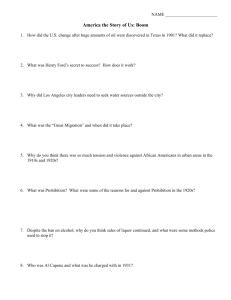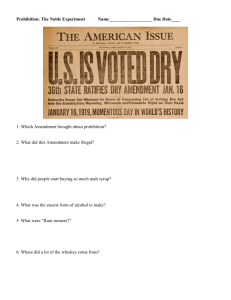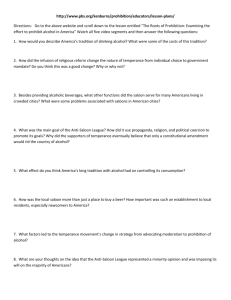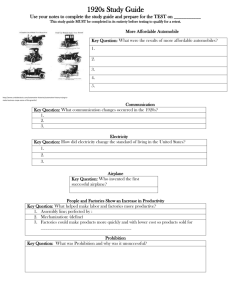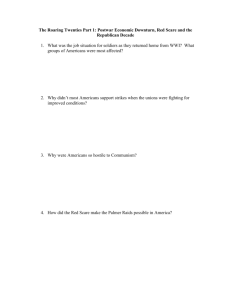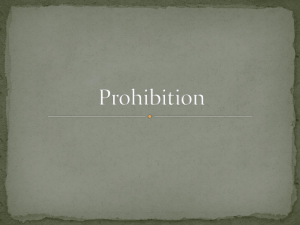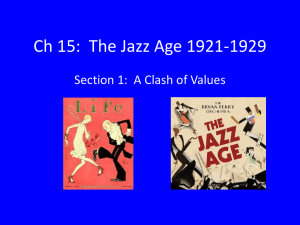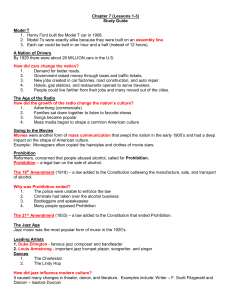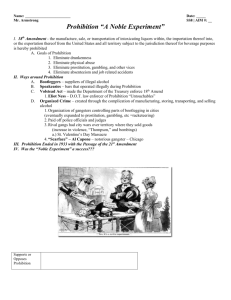prohibitionword.doc - St. Francis Xavier University
advertisement
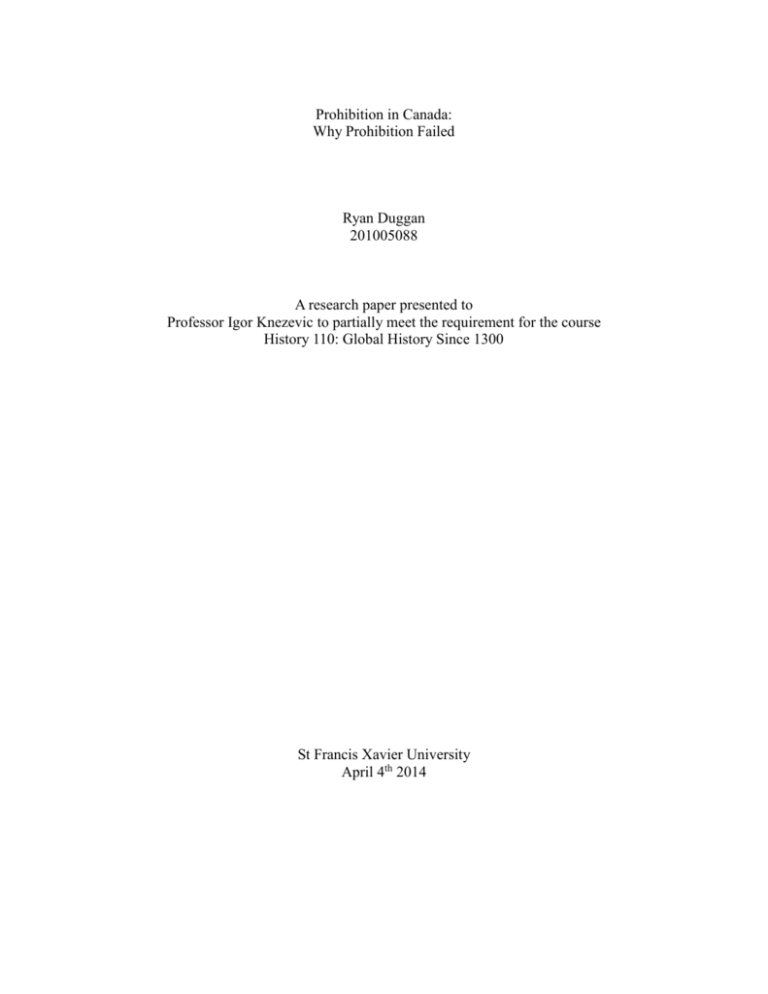
Prohibition in Canada: Why Prohibition Failed Ryan Duggan 201005088 A research paper presented to Professor Igor Knezevic to partially meet the requirement for the course History 110: Global History Since 1300 St Francis Xavier University April 4th 2014 Prohibition in Canada: why prohibition failed Alcohol prohibition in Canada occurred at different times in different provinces in the early 1900’s. Prohibition in Canada banned the selling, purchase and manufacturing of liquor. There were various reasons why Canada used prohibition and there were a wide range of views and groups for prohibition as well as against the ban of alcohol. With the sale and fabrication of alcohol today, it's hard to believe that not too long ago prisons were full of bootleggers and barkeeps that were running illegal speakeasies. Canada has a long history with alcohol that has lead to today's liquor regulations after having many years of both sides battling it out for the right to have a drink. Others took advantage of the banned drink to generate profit. In any case, alcohol prohibition in Canada was a failure from the beginning. The first move for prohibition in Canada began as early as the 1860's with The Dunkin Act, or the Canada Temperance Act (1864). This act allowed counties and municipalities to prohibit the retail sale of alcohol if supported by a majority vote.(Warsh, 1993, p.144) The push was titled the temperance movement, it's core goal was to remove all drinking establishments from communities across Canada. The reason behind this movement was due to large groups that were blaming alcohol as a major contributor or cause of many hardships and societal problems.(Warsh, 1993, p.48) Although some of the concerns were related to communities as a whole such as crime, poverty and disease. However, even with the passing of the Dunkin or Temperance act, very few communities went dry. The largest group advocating the ban of alcoholic drinks were women. In 1874, The Woman's Christian Temperance Union of Canada was formed, claimed that alcohol was the cause of spousal abuse and marital problems.(Lefebvre, 2001, p.34) There were also heavy religious undertones to the movement from Baptist, Methodist and Presbyterians. However, the majority of people that were allowed to vote wanted to continue the sale and consumption of alcohol, meanwhile the women of Canada were still lacking a political voice and couldn't help sway the decision. Women's fight against alcohol before and during World War I was compounded by the push to have more of a voice both socially and politically. The Women's suffrage Movement was also in full swing at this time focusing on political equality and the right to vote in elections. Since making alcohol illegal to manufacture, sell and export would have to go through governmental legislation, the decision would come down to a vote, at least preliminarily. Being that women's social and religious group were the main drivers for prohibition they needed to have their voice heard. Not being able to vote provincially or federally create a huge barrier. By 1875, Hundreds of groups spanning different social interest and religious groups in Montreal from the Dominion Prohibitory Council joined the fight for alcohol reform and prohibition. The lead to the introduction of The Scott Act which extended the Canada Temperance Act Nationally. Although there was such a large force for prohibition, it wasn't until 1898 when Canada’s first attempt at a federal prohibition was made. After a federal referendum under Sir Wilfred Laurier’s government on complete prohibition. A tally of 51% for the ban of alcohol was achieved. However this was a non-binding referendum and due to the disparity across provinces such as a massive 71% against in Quebec, a bill was never enacted for federal prohibition. (Dostie,2012) However, there was another province with a anomaly on the referendum, P.E.I only had a 20% minority against prohibition and became the first province to officially enact prohibition in 1901. (Dostie, 2012, table 3) Women gained the right to vote provincially in 1916 and 1917 in some provinces, Manitoba, Saskatchewan, Alberta, BC and Ontario. The Maritimes and Yukon took longer to adapt to this social change and women didn't have the vote until 1925. The fact that prohibition was passed in most of these provinces after women gained the right to vote is attributed to the impact of suffrage and temperance movements. (Dostie, 2012) With WWI underway prohibition was brought to the table again with the hopes on preserving food rations. The amount of food such as grain that was sent to help the war effort made food more scarce and required it to be rationed throughout the country.(Blocker,2006) There was such a huge demand for farmer produce to go overseas the remainder that could be consumed and sold locally was drastically reduced. It was seen as a necessary sacrifice to keep the produce for food rather than turning it into alcohol.(Dostie,2012) Leading to some governments enacting formal prohibition of the manufacture of liquor to ration grain and fruits for the war effort. This was the start of a widespread prohibition. This is also the first time that prohibition supporters were not simply protesting for prohibition due to religious or reasons of social change, but supporters were also worried about the increasing cost and scarcity of food to feed their families on low income. Not only was the prohibition to help with the food supplies, but the ban on alcohol was also meant to increase civil and military efficiency by not allowing Canadians to get drunk. The theory was that factory workers who were intoxicated at work or even the night before work that they were less efficient which meant they weren't doing everything in their power to get finished goods to the frontlines. (Blocker, 2006) It was also said that there would be an increase in absenteeism from the workplace which would also cause a reduction in efficiency. In the countries time of need, everyone was required to help with the war effort including factory workers from most industries including ammunition manufacturing and farming. The more efficient workers were the more yield or units of production were created to help fight overseas. Due to the rationing of food and the problem of efficiency, between 1915 and 1917 all provinces, except Quebec and Yukon, enacted prohibition under the War Measures Act of 1914. Although this was a national act, the specifics were different depending on the province. For example, in Ontario, it was not illegal to manufacture alcoholic beverages as long as it was not sold within the province.(Lefebvre, 2001, p.34) This lead to massive exportation of liquor out of Ontario while not violating the Ontario Temperance Act of 1916. Although the exportation of alcohol wasn't illegal in Canada, where the Ontario distilleries were transporting this alcohol became a very profitable business due to the United States of America's prohibition. Bootlegging Canadian made liquor to the United States was a lucrative business until the end of the American prohibition in 1933.(Warsh, 1993, p.167) This was sue to alcohol regulations in America being even stricter than in Canada. In America there was a ban on the manufacture, sale and transportation of all types of alcohol. However, Canadians could brew and transport liquor from Canadian ports legally. Although a legal gray zone, alcohol smuggling or “run running” often brought violence along port cities. (Lefebvre,2001, p.37) Since a province couldn't legislate out of their province to try and curb the exportation of distilled liquor made in one province to a province where the distilling of liquor was prohibited the Canadian government banned all inter provincial trade of liquor in 1918. Quebec joins the rest of Canada with prohibition laws in 1919. By 1924 provinces begin to change their prohibition regulations by changing back to a system where each province runs their system independently, which ultimately ends alcohol prohibition in most provinces. 1948 is the last year of prohibition in Canada when P.E.I finally bring alcohol back to its citizens. (Dostie, 2012, table 1) The main problem with prohibition is that there was still a huge part of the Canadian population that still wanted alcohol. There were countless loop-holes to be able to get a taste of alcohol. Doctors could write scripts for pints for patients that were “ill” this system lead to a lot of abuse. The longest lines for sick patients waiting to have alcohol prescriptions filled were during holiday seasons. Canadians vacationed and flocked to Quebec when laws hadn't caught up to the rest of Canada's regulations.(Globe, p.10) Another problem facing authorities trying to thwart the illegal production of alcohol is that it's so simple to manufacture. Almost anyone could produce substantial quantities of drinkable alcohol with a basic home still. At the time, there were even a large population of police officers that didn't believe in prohibition and were therefore not enforcing the letter of the law. Another reason prohibition was seen as a failure was the massive amount of gang activity. The enormous profits made by the manufacturing and the smuggling of illegal alcohol were directly related to the prohibition, since scarcity and the risk taken by smugglers drove up prices. Gang murder showed a dramatic increase in the murder rate and no amount of policing was enough to stop criminals seeking the profits from illegal liquor.(Lefebvre, 2001, p.33) Eventually the government gave up on prohibition since it couldn't stop the population from seeking out alcohol. The problems that it looked to solve by prohibition such as safety of citizens, lowering of costs to the government by reducing crime and prisoners, lower crime rates, higher productivity and many more. In reality, the banning of alcohol increased the number of incarcerations due to the massive amount of arrests from new liquor laws.(Thornton, 1991) Another factor that lead to increased cost to the government was the need for extra border guards and coast guard to reduce the smuggling of liquor.(Thornton, 1991) The prohibition that was that was supposed to help maintain the economic boom that had been going on since the end of the First World War was proven wrong after the stock market crash of 1929.It was therefore far more cost efficient for legal regulated alcohol which produce huge revenues from the taxation of alcohol.(Warsh, 1993, p.172) The regulation by the government also help keep alcohol out of the hands of minors, something that having a black market for alcohol increased the availability to youth.(Thornton, 1991) In conclusion, prohibition did not live up to the promises of supporters. Many early supporters of prohibition ended up seeing the theory run its course. Instead of delivering a utopian society, the prohibition compounded many problems such as crime and incarcerations. Not only did existing problems transform negatively, the ban also added new problems like increasing gang violence and government corruption. By the end of prohibition it was the criminals that were in support of outlaw of alcohol since their livelihood depended on the outlaw regulations staying in place. Government regulation disposed of most of the problems that were caused by prohibition. There was a dramatic reduction in crime, especially organized crime, and corruption. Since it was now a legal substance there were help groups created such as Alcoholics Anonymous to aid problem drinkers, founded in 1934. Employees productivity improved as well as absenteeism which was good for national production once the regulation of alcohol became common. The reason for this was also due to the reduction of the black market alcohol. This is in part because at the beginning of prohibition many citizens decided to enter the black market manufacturing and smuggling business since it was far more lucrative than factory work. Job creation was side effect of the regulation of alcohol, from government run liquor stores to a storm of breweries and distilleries that opened soon after the end of prohibition. It allowed taxes to be collected which were and still are a major revenue stream for government. During the ban on alcohol it was never difficult to acquire due to the aforementioned reasons such as ease of manufacture and widespread accessibility of bootleggers. Regulation reducing youths exposure to alcohol by having licensed establishments which required identification to those of legal age for consumption. This alone has created vast imporvements in the development of children and the safety of the younger developing generations. Works Cited Warsh, Cheryl Lynn Krasnick. 1993. Drink in Canada historical essays. Montreal [Que.]: McGillQueen's University Press. http://site.ebrary.com/id/10135025. Dostie, B., and R. Dupre. 2012. "''The people's will'': Canadians and the 1898 referendum on alcohol prohibition". Explorations in Economic History. 49 (4): 498-515. Blocker JS Jr. 2006. "Did prohibition really work? Alcohol prohibition as a public health innovation". American Journal of Public Health. 96 (2): 233-43. Principal Grant's letters on prohibition [microform] : as they appeared in the Toronto daily "Globe", December, 1897, January, 1898 (1898) “Prohibition in Canada”. Prohibition in Canada, BlogSpot http://prohibitionincanada.blogspot.ca/p/prohibition-timeline.html Lefebvre, Andrew. 2001. Prohibition and the Smuggling of Intoxicating Liquors between the Two Saults.11 (3): 33-40 Thornton, Mark. 1991. Cato Institute Policy Analysis No. 157: Alcohol Prohibition Was a Failure.http://object.cato.org/sites/cato.org/files/pubs/pdf/pa157.pdf
